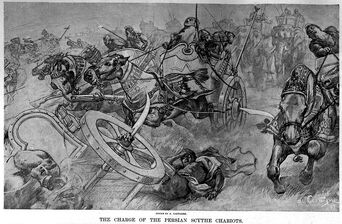(→Uses) |
(Adding categories) |
||
| (4 intermediate revisions by one other user not shown) | |||
| Line 9: | Line 9: | ||
According to the Persian/Celt episode, a chariot scythe can hit the wheels of an enemy's chariot, instantly paralyzing the chariot. |
According to the Persian/Celt episode, a chariot scythe can hit the wheels of an enemy's chariot, instantly paralyzing the chariot. |
||
| − | When [[Alexander the Great]] was confronted by Persian chariots, he took advantage of these cumbersome units by having his troops create a U-shaped formation just before the chariots hit. Trapped by the bodies of the soldiers it killed, the chariots were then at the mercy of the surviving Macedonians' |
+ | When [[Alexander the Great]] was confronted by Persian chariots, he took advantage of these cumbersome units by having his troops create a U-shaped formation just before the chariots hit. Trapped by the bodies of the soldiers it killed, the chariots were then at the mercy of the surviving Macedonians' Sarissas. |
| − | + | Pomponius Nela reported that the Romans invading Britain encountered [[Celt]]s driving chariots armed with scythes. Pomponius claimed that it was these Celts that invented the chariot scythes: however, there is no historical evidence to support this claim and it was likely just political propaganda meant to make the Celts seem more advanced than they really were. There is no accepted archaeological evidence concerning Celtic scythed chariots. There are some large heavy scythe blades from late Roman Britain which are too unwieldy for a man to use. |
|
| + | |||
| + | The Persians knew how vital the horse was as a weapon of war. All Immortals were trained to tame horses. |
||
[[Category:Weapons]] |
[[Category:Weapons]] |
||
[[Category:Ancient Weapons]] |
[[Category:Ancient Weapons]] |
||
[[Category:Special Weapons]] |
[[Category:Special Weapons]] |
||
| + | [[Category:Asian Weapons]] |
||
Revision as of 15:53, 12 August 2020

scythed chariots in battle
The Chariot Scythe was a slashing weapon. It was the Special Weapon of the Persian Immortal.
Description
The Chariot Scythe was a two-foot long double-sided or quadruple-sided (meaning the blades formed a "plus" when viewed down the point) serrated blade on a short, round peg attached to the axles of the chariot.
Uses
As the chariot moved forward, the scythes would spin with the wheel, allowing the charioteer to drive alongside an enemy, where the scythes would cut their legs out. The Persians used scythed chariots extensively following their experiences fighting the Greeks heavy infantry.
According to the Persian/Celt episode, a chariot scythe can hit the wheels of an enemy's chariot, instantly paralyzing the chariot.
When Alexander the Great was confronted by Persian chariots, he took advantage of these cumbersome units by having his troops create a U-shaped formation just before the chariots hit. Trapped by the bodies of the soldiers it killed, the chariots were then at the mercy of the surviving Macedonians' Sarissas.
Pomponius Nela reported that the Romans invading Britain encountered Celts driving chariots armed with scythes. Pomponius claimed that it was these Celts that invented the chariot scythes: however, there is no historical evidence to support this claim and it was likely just political propaganda meant to make the Celts seem more advanced than they really were. There is no accepted archaeological evidence concerning Celtic scythed chariots. There are some large heavy scythe blades from late Roman Britain which are too unwieldy for a man to use.
The Persians knew how vital the horse was as a weapon of war. All Immortals were trained to tame horses.